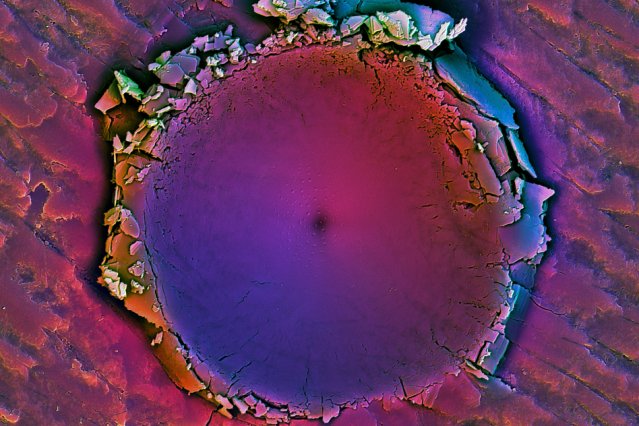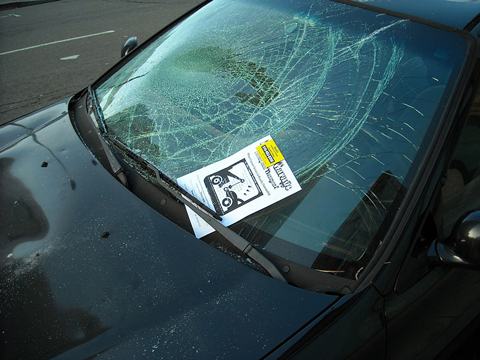Bio-inspired transparent synthetic materials could protect cars and people
April 15, 2014

A Scanning Electron Microscope (SEM) image of the region surrounding an indentation the researchers made in a piece of shell from Placuna placenta. The image shows the localization of damage to the area immediately surrounding the stress. (Credit: Ling Li and James C. Weaver)
MIT researchers have analyzed the shells of a sea creature, the mollusk Placuna placenta to determine exactly why they are so resistant to penetration and damage — even though they are 99 percent calcite, a weak, brittle mineral. The shells are exceptionally tough but clear enough to read through,
The properties of this natural armor make it a promising template for the development of bio-inspired synthetic materials for both commercial and military applications — such as windows and windshields, eye and face protection for soldiers, and blast shields, says Christine Ortiz, the MIT Morris Cohen Professor of Materials Science and Engineering.
The shells’ unique properties emerge from a specialized nanostructure that allows optical clarity, as well as efficient energy dissipation and the ability to localize deformation, the researchers found. The results are published in the journal Nature Materials, in a paper co-authored by MIT graduate student Ling Li.
Engineered ceramic-based armor, while designed to resist penetration, often lacks the ability to withstand multiple blows, due to large-scale deformation and fracture that can compromise its structural integrity, Ortiz says. In transparent armor systems, such deformation can also obscure visibility.
How natural exoskeletons withstand attacks
Creatures that have evolved natural exoskeletons — many of them ceramic-based — have developed ingenious designs that can withstand multiple penetrating attacks from predators. The shells of a few species, such as Placuna placenta, are also optically clear.
To test exactly how the shells — which combine calcite with about 1 percent organic material — respond to penetration, the researchers subjected samples to indentation tests, using a sharp diamond tip in an experimental setup that could measure loads precisely. They then used high-resolution analysis methods, such as electron microscopy and diffraction, to examine the resulting damage.
The material initially isolates damage through an atomic-level process called “twinning” within the individual ceramic building blocks: A crystal breaks up into a pair of mirror-image regions that share a common boundary, rather like a butterfly’s wings. This twinning process occurs all around the stressed region, helping to form a kind of boundary that keeps the damage from spreading outward.
The MIT researchers found that twinning then activates “a series of additional energy-dissipation mechanisms … which preserve the mechanical and optical integrity of the surrounding material,” Li says. This produces a material that is 10 times more efficient in dissipating energy than the pure mineral, Li adds.
The work was supported by the National Science Foundation; the U.S. Army Research Office through the MIT Institute for Soldier Nanotechnologies; the National Security Science and Engineering Faculty Fellowships Program; and the Office of the Assistant Secretary of Defense for Research and Engineering.
Abstract of Nature Materials paper
Hierarchical composite materials design in biological exoskeletons achieves penetration resistance through a variety of energy-dissipating mechanisms while simultaneously balancing the need for damage localization to avoid compromising the mechanical integrity of the entire structure and to maintain multi-hit capability. Here, we show that the shell of the bivalve Placuna placenta (~99 wt% calcite), which possesses the unique optical property of ~80% total transmission of visible light, simultaneously achieves penetration resistance and deformation localization via increasing energy dissipation density (0.290 ± 0.072 nJ μm−3) by approximately an order of magnitude relative to single-crystal geological calcite (0.034 ± 0.013 nJ μm−3). P. placenta, which is composed of a layered assembly of elongated diamond-shaped calcite crystals, undergoes pervasive nanoscale deformation twinning (width ~50 nm) surrounding the penetration zone, which catalyses a series of additional inelastic energy dissipating mechanisms such as interfacial and intracrystalline nanocracking, viscoplastic stretching of interfacial organic material, and nanograin formation and reorientation.
